View in other NatureServe Network Field Guides
NatureServe
Montana
Utah
Wyoming
Idaho
Wisconsin
British Columbia
South Carolina
Yukon
California
New York
American Mink - Neogale vison
Other Names:
Neovison vison, Vison vison, Mustela vison
Native Species
Global Rank:
G5
State Rank:
S4
(see State Rank Reason below)
Agency Status
USFWS:
USFS:
BLM:
External Links
State Rank Reason (see State Rank above)
Species is common and relatively widespread in wetlands across the state. It is apparently declining for unknown reasons. Threats are poorly understood.
General Description
This medium-sized, semi-aquatic carnivore has a long, thin body; short, sturdy legs; short, pointed nose; short, rounded ears, and a dorsoventrally flattened head. Thickly furred tail. Usually rich dark brown in color with a white chin patch. Sometimes white spots on belly. Fur is soft and lustrous with long, glossy guard hairs. Dense pelage is its only obvious aquatic adaptation. Total length: 19 to 28 inches. Weight: 1.5 to two pounds. A medium-sized mammal with an elongate body, a long tail, small rounded ears, and relatively short legs; pelage is soft, luxurious, and generally rich brown to almost black dorsally; the underparts are paler, sometimes with a whitish chin patch and whitish spotting elsewhere; five digits on each foot; head to body 330 to 430 mm in males, 300 to 400 mm in females; tail 158 to 230 mm in males, 128 to 200 mm in females; mass 681 to 2310 g in males, 790 to 1089 g in females; basilar length of skull 58 to 69 mm (Burt and Grossenheider 1964, Hall 1981, and Nowak 1991).
Diagnostic Characteristics
Differs from weasels in having brown rather than white or yellowish underparts. Differs from Marten in having a white chin patch (Marten has pale buff patch on throat and breast), generally darker pelage (Marten's pelage generally is yellowish brown except on the feet and end of the tail), and 4 rather than 5 upper postcanine teeth. Differs from the Fisher in having 4 rather than 5 upper postcanine teeth, a white chin patch, and smaller size. River Otter is much larger (up to 130 cm total length and 11 kg).
Species Range
Montana Range
Range Descriptions
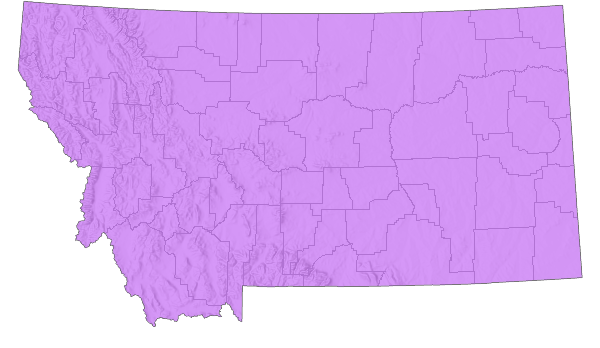
 Native
Native
Western Hemisphere Range

Observations in Montana Natural Heritage Program Database
Number of Observations: 418
(Click on the following maps and charts to see full sized version)
Map Help and Descriptions
Relative Density
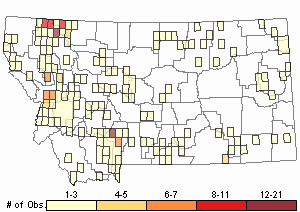
Recency
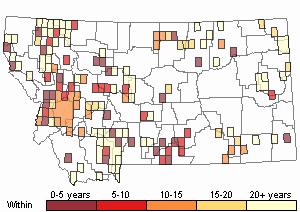
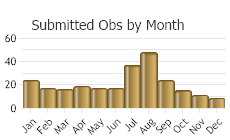
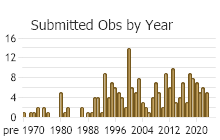
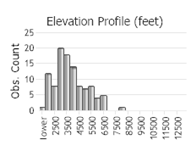 (Observations spanning multiple months or years are excluded from time charts)
(Observations spanning multiple months or years are excluded from time charts)
Migration
Non-migratory. Males make extensive movements and juveniles disperse.
Habitat
Usually found along streams and lakes. Commonly occurs in marshes and beaver ponds. Permanence of water and dependable source of food are most important habitat components. Often uses den sites of other animals and is commonly found in association with Muskrats. Semi-aquatic forager. Can kill prey larger than itself. Chiefly nocturnal, territorial, and secretive. Dens underneath piles of brush or driftwood, under rocks, in hollow logs, and in houses or dens abandoned by Beavers or Muskrats. Very aggressive mating behavior. Wetland habitats - riverine, palustrine, lacustrine.
National Vegetation Classification System Groups Associated with this Species
Forest and Woodland
Deciduous Forest and Woodland
Montane - Subalpine Forest and Woodland
Shrubland
Sagebrush Shrubland
Grassland
Lowland - Prairie Grassland
Montane - Subalpine Grassland
Wetland and Riparian
Alkaline - Saline Wetlands
Alpine Riparian and Wetland
Peatland
Riparian and Wetland Forest
Riparian Shrubland
Wet Meadow and Marsh
Human Land Use
Agriculture
Developed
Food Habits
Preys primarily on small mammals, birds, eggs, frogs, and fish. Its diet is almost entirely animal. During summer preys on waterfowl. Aquatic and terrestrial prey. Order of importance varies. Lacustrine: fish, mammals, invertebrates, birds, reptiles and amphibians. Palustrine: birds, invertebrates, mammals, reptiles and amphibians. Opportunistic.
Ecology
Almost complete population turnover within 3 years. Diameter of movements for males usually not greater than 3 miles. Two adjacent females had home ranges of 19.3 and 50.4 acres.
Reproductive Characteristics
Mates from January through March; 40- to 79-day gestation; delayed implantation; young born during April or May; averages four or five per litter. Apparently breed in March, perhaps earlier. Average 4 young per litter. Born in April or May. By 8 weeks of age, the young may accompany female on hunting trips.
Stewardship Responsibility
References
- Literature Cited AboveLegend:
 View Online Publication
View Online Publication Burt, W.H. and R.P. Grossenheider. 1964. A field guide to the mammals. Houghton Mifflin Co.
Burt, W.H. and R.P. Grossenheider. 1964. A field guide to the mammals. Houghton Mifflin Co. Hall, E.R. 1981. The mammals of North America, volumes I and II. John Wiley & Sons, New York, NY. 1181 pp.
Hall, E.R. 1981. The mammals of North America, volumes I and II. John Wiley & Sons, New York, NY. 1181 pp. Nowak, R.M. 1991. Walker's mammals of the world. Fifth edition. Volumes I and II. Johns Hopkins University Press, Baltimore. 1629 pp.
Nowak, R.M. 1991. Walker's mammals of the world. Fifth edition. Volumes I and II. Johns Hopkins University Press, Baltimore. 1629 pp.
- Additional ReferencesLegend:
 View Online Publication
View Online Publication
Do you know of a citation we're missing? Adelman, E.B. 1979. A survey of the nongame mammals in the Upper Rattlesnake Creek drainage of western Montana. M.S. thesis. University of Montana, Missoula. 129 pp.
Adelman, E.B. 1979. A survey of the nongame mammals in the Upper Rattlesnake Creek drainage of western Montana. M.S. thesis. University of Montana, Missoula. 129 pp. Allen, A. W. 1983. Habitat suitability index models: mink. U.S. Fish and Wildlife Service. FWS/OBS-82/10.61 19 pp.
Allen, A. W. 1983. Habitat suitability index models: mink. U.S. Fish and Wildlife Service. FWS/OBS-82/10.61 19 pp. Anaconda Minerals Company, and Camp, Dresser & McKee. 1981. Anaconda Stillwater Project 6-month environmental baseline report. CDM Project No. 3139. Vol. I Appendix. Jan. 15, 1981.
Anaconda Minerals Company, and Camp, Dresser & McKee. 1981. Anaconda Stillwater Project 6-month environmental baseline report. CDM Project No. 3139. Vol. I Appendix. Jan. 15, 1981. Andersen, K. W., and J. K. Jones, Jr. 1971. Mammals of northwestern South Dakota. Univ. Kan Mus. Nat. Hist. Pub. 19:361-393.
Andersen, K. W., and J. K. Jones, Jr. 1971. Mammals of northwestern South Dakota. Univ. Kan Mus. Nat. Hist. Pub. 19:361-393. Arnold, T. W. and E. K. Fritzell. 1990. Habitat use by male mink in relation to wetland characteristics and avian prey abundance. Can. J. Zool. 68:2205-2208.
Arnold, T. W. and E. K. Fritzell. 1990. Habitat use by male mink in relation to wetland characteristics and avian prey abundance. Can. J. Zool. 68:2205-2208. Bauer, Delane, 2002, 2002 Four Seasons Wildlife Study. Savage Mine Report, Richland County, Montana.
Bauer, Delane, 2002, 2002 Four Seasons Wildlife Study. Savage Mine Report, Richland County, Montana. Bell, J. F., K. Farrell and J. R. Gorham. 1957. A polyvalent toxoid for botulism in mink. Am. J. Vet. Res. 18(66):167-170.
Bell, J. F., K. Farrell and J. R. Gorham. 1957. A polyvalent toxoid for botulism in mink. Am. J. Vet. Res. 18(66):167-170. Breault, A.M. and K.M. Cheng. 1988. Surplus killing of eared grebes, Podiceps nigricollis, by mink, Mustela vison, in central British Columbia. Canadian Field-Naturalist 102(4):738-739.
Breault, A.M. and K.M. Cheng. 1988. Surplus killing of eared grebes, Podiceps nigricollis, by mink, Mustela vison, in central British Columbia. Canadian Field-Naturalist 102(4):738-739. Butts, T.W., Western Technology and R.L. Eng. 1993. Continental Lime Indian Creek Mine, Townsend, MT. Life of Mine Wildlife Reconnaissance. In Life-of-Mine Amendment. Continental Lime, Inc., Indian Creek Mine & Plant. Vol. 2. October 13, 1992.
Butts, T.W., Western Technology and R.L. Eng. 1993. Continental Lime Indian Creek Mine, Townsend, MT. Life of Mine Wildlife Reconnaissance. In Life-of-Mine Amendment. Continental Lime, Inc., Indian Creek Mine & Plant. Vol. 2. October 13, 1992. Carlsen, T. and R. Northrup. 1992. Canyon Ferry Wildlife Management Area Final Draft Management Plan. March 1992.
Carlsen, T. and R. Northrup. 1992. Canyon Ferry Wildlife Management Area Final Draft Management Plan. March 1992. Chapman, J.A., and G.A. Feldhamer. 1982. Wild mammals of North America: biology, management, and economics. Johns Hopkins University Press, Baltimore, Maryland.
Chapman, J.A., and G.A. Feldhamer. 1982. Wild mammals of North America: biology, management, and economics. Johns Hopkins University Press, Baltimore, Maryland. Cross, James, and Richard P. Weckwerth, 1978, Upland Game Bird (and Fur Survey) Inventory. Wildlife Investigations, Region One. W-130-R-9, Job No. II-1, July 1, 1977 - June 30, 1978.
Cross, James, and Richard P. Weckwerth, 1978, Upland Game Bird (and Fur Survey) Inventory. Wildlife Investigations, Region One. W-130-R-9, Job No. II-1, July 1, 1977 - June 30, 1978. Cross, James, and Richard P. Weckwerth, 1980, Upland Game Bird (and Fur Survey) Inventory. Wildlife Investigations, Region One. W-130-R-11, Job No. II-1, July 1, 1979 - June 30, 1980.
Cross, James, and Richard P. Weckwerth, 1980, Upland Game Bird (and Fur Survey) Inventory. Wildlife Investigations, Region One. W-130-R-11, Job No. II-1, July 1, 1979 - June 30, 1980. Cross, James, and Richard P. Weckwerth, 1981, Upland Game Bird (and Fur Survey) Inventory. Wildlife Investigations, Region One. W-130-R-12, Job No. II-1, July 1, 1980 - June 30, 1981.
Cross, James, and Richard P. Weckwerth, 1981, Upland Game Bird (and Fur Survey) Inventory. Wildlife Investigations, Region One. W-130-R-12, Job No. II-1, July 1, 1980 - June 30, 1981. Cross, James, and Richard P. Weckwerth, 1982, Upland Game Bird (and Fur Survey) Inventory. Wildlife Investigations, Region One. W-130-R-13, Job No. II-1, July 1, 1981 - June 30, 1982.
Cross, James, and Richard P. Weckwerth, 1982, Upland Game Bird (and Fur Survey) Inventory. Wildlife Investigations, Region One. W-130-R-13, Job No. II-1, July 1, 1981 - June 30, 1982. Cross, James, and Richard P. Weckwerth, 1983, Upland Game Bird (and Fur Survey) Inventory. Wildlife Investigations, Region One. W-130-R-14, Job No. II-1, July 1, 1982 - June 30, 1983.
Cross, James, and Richard P. Weckwerth, 1983, Upland Game Bird (and Fur Survey) Inventory. Wildlife Investigations, Region One. W-130-R-14, Job No. II-1, July 1, 1982 - June 30, 1983. Deems, E.F., Jr. and D. Pursley (eds). 1978. North American furbearers: their management, research and harvest status in 1976. Int. Assoc. Fish and Wildlife Agencies and University of Maryland. 171 p.
Deems, E.F., Jr. and D. Pursley (eds). 1978. North American furbearers: their management, research and harvest status in 1976. Int. Assoc. Fish and Wildlife Agencies and University of Maryland. 171 p. Flath, D. L. 1984. Vertebrate species of special interest or concern. Mammals, birds, reptiles, amphibians, fishes. Spec. Publ. Montana Department of Fish, Wildlife, and Parks, Helena. 76 pp.
Flath, D. L. 1984. Vertebrate species of special interest or concern. Mammals, birds, reptiles, amphibians, fishes. Spec. Publ. Montana Department of Fish, Wildlife, and Parks, Helena. 76 pp. Foresman, K.R. 2001. The wild mammals of Montana. American Society of Mammalogists, Special Publication Number 12. Lawrence, KS. 278 pp.
Foresman, K.R. 2001. The wild mammals of Montana. American Society of Mammalogists, Special Publication Number 12. Lawrence, KS. 278 pp. Foresman, K.R. 2012. Mammals of Montana. Second edition. Mountain Press Publishing, Missoula, Montana. 429 pp.
Foresman, K.R. 2012. Mammals of Montana. Second edition. Mountain Press Publishing, Missoula, Montana. 429 pp. Gniadek, S. 1983. Southwest Glendive Wildlife Baseline Inventory. Miles City, Mont: Bureau of Land Management, Miles City District Office. 56 pp with appendices.
Gniadek, S. 1983. Southwest Glendive Wildlife Baseline Inventory. Miles City, Mont: Bureau of Land Management, Miles City District Office. 56 pp with appendices. Greer, K. R. 1957. Some osteological character of known-age ranch minks. J. Mammal. 38:319-330.
Greer, K. R. 1957. Some osteological character of known-age ranch minks. J. Mammal. 38:319-330. Halvorson, C.H., R.M. Engleman. 1983. Survival Analysis for a Red Squirrel Population. Journal of Mammalogy. 64(2): 332-336.
Halvorson, C.H., R.M. Engleman. 1983. Survival Analysis for a Red Squirrel Population. Journal of Mammalogy. 64(2): 332-336. Hjelle, B.T. 1948. The mink in North Dakota. North Dakota Outdoors, 10(9):12-14.
Hjelle, B.T. 1948. The mink in North Dakota. North Dakota Outdoors, 10(9):12-14. Hoffmann, R.S. and D.L. Pattie. 1968. A guide to Montana mammals: identification, habitat, distribution, and abundance. Missoula, MT: University of Montana. 133 p.
Hoffmann, R.S. and D.L. Pattie. 1968. A guide to Montana mammals: identification, habitat, distribution, and abundance. Missoula, MT: University of Montana. 133 p. Johnson, L.J. 1960. Mammal studies on the Lubrecht Forest, Montana: a preliminary report. Proc. Mont. Acad. Sci. 20: 40-47.
Johnson, L.J. 1960. Mammal studies on the Lubrecht Forest, Montana: a preliminary report. Proc. Mont. Acad. Sci. 20: 40-47. Joslin, Gayle, and Heidi B. Youmans. 1999. Effects of recreation on Rocky Mountain wildlife: a review for Montana. [Montana]: Montana Chapter of the Wildlife Society.
Joslin, Gayle, and Heidi B. Youmans. 1999. Effects of recreation on Rocky Mountain wildlife: a review for Montana. [Montana]: Montana Chapter of the Wildlife Society. Keith, L. B. and J. R. Cary 1991. Mustelid, squirrel and porcupine population trends during a snowshoe hare cycle. J. Mammal. 72(2):373-378.
Keith, L. B. and J. R. Cary 1991. Mustelid, squirrel and porcupine population trends during a snowshoe hare cycle. J. Mammal. 72(2):373-378. Key, C.H. 1979. Mammalian utilization of floodplain habitats along the North Fork of the Flathead River in Glacier National Park, Montana. M.S. thesis. University of Montana, Missoula.
Key, C.H. 1979. Mammalian utilization of floodplain habitats along the North Fork of the Flathead River in Glacier National Park, Montana. M.S. thesis. University of Montana, Missoula. Lariviere, S.. 1999. Mustela vison. American Society of Mammalogists, Lawrence, KS. Mammalian Species No. 608:1-9.
Lariviere, S.. 1999. Mustela vison. American Society of Mammalogists, Lawrence, KS. Mammalian Species No. 608:1-9. Lechleitner, R.R. 1953. An analysis of some age criteria in a domestic and a wild population of Mink (Mustela vison). M.S. thesis. University of Montana, Missoula. 54 pp.
Lechleitner, R.R. 1953. An analysis of some age criteria in a domestic and a wild population of Mink (Mustela vison). M.S. thesis. University of Montana, Missoula. 54 pp. Lokemoen, J.T. 1993. Increasing waterfowl nesting success on islands and peninsulas. Ch. 13.2.11 In: Waterfowl Management Handbook. Fish and Wildlife Service Leaflet. 7 p.
Lokemoen, J.T. 1993. Increasing waterfowl nesting success on islands and peninsulas. Ch. 13.2.11 In: Waterfowl Management Handbook. Fish and Wildlife Service Leaflet. 7 p. Martin, P.R., K. Dubois and H.B. Youmans. 1981. Terrestrial wildlife inventory in selected coal areas, Powder River resources area final report. Montana Department of Fish, Wildlife and Parks and Bureau of Land Management, Helena, MT. No. YA-553-CTO- 24. 288 p.
Martin, P.R., K. Dubois and H.B. Youmans. 1981. Terrestrial wildlife inventory in selected coal areas, Powder River resources area final report. Montana Department of Fish, Wildlife and Parks and Bureau of Land Management, Helena, MT. No. YA-553-CTO- 24. 288 p. Matthews, W.L. 1981. Broadus-Pumpkin Creek baseline inventory - wildlife. Bureau of Land Management, Miles City, MT. 83 p.
Matthews, W.L. 1981. Broadus-Pumpkin Creek baseline inventory - wildlife. Bureau of Land Management, Miles City, MT. 83 p. Mead, E.M. and J.I. Mead. 1989. Snake Creek burial cave and a review of the Quaternary mustelids of the Great Basin. Great Basin Naturalist 49(2):143-154.
Mead, E.M. and J.I. Mead. 1989. Snake Creek burial cave and a review of the Quaternary mustelids of the Great Basin. Great Basin Naturalist 49(2):143-154. Mitchell, J. L. 1958. Mink age and sex ratios. Montana Fish and Game Dept. P-R Job Compl. Rep. Proj. W-49-R-7:8-15.
Mitchell, J. L. 1958. Mink age and sex ratios. Montana Fish and Game Dept. P-R Job Compl. Rep. Proj. W-49-R-7:8-15. Mitchell, J.L. 1961. Mink movements and a population on a Montana river. J. Wildl. Manage. 25(1):48-54.
Mitchell, J.L. 1961. Mink movements and a population on a Montana river. J. Wildl. Manage. 25(1):48-54. Mitchell, James L. 1957. A Study of Mink Movements and Populations on the Lower Madison River, Montana. M.Sc. Thesis. Bozeman, Montana: Montana State University. 19 p.
Mitchell, James L. 1957. A Study of Mink Movements and Populations on the Lower Madison River, Montana. M.Sc. Thesis. Bozeman, Montana: Montana State University. 19 p. Montana Dept. of Fish, Wildlife & Parks, 1985, Upland Game Bird and Furbearer Survey and Inventory. Wildlife Investigations, Region One. W-130-R-16, Job No. II-1, July 1, 1984 - June 30, 1985.
Montana Dept. of Fish, Wildlife & Parks, 1985, Upland Game Bird and Furbearer Survey and Inventory. Wildlife Investigations, Region One. W-130-R-16, Job No. II-1, July 1, 1984 - June 30, 1985. Montana Dept. of Fish, Wildlife & Parks, 1986, Upland Game Bird and Furbearer Survey and Inventory. Wildlife Investigations, Region One. W-130-R-17, Job No. II-1, July 1, 1985 - June 30, 1986.
Montana Dept. of Fish, Wildlife & Parks, 1986, Upland Game Bird and Furbearer Survey and Inventory. Wildlife Investigations, Region One. W-130-R-17, Job No. II-1, July 1, 1985 - June 30, 1986. Montana Dept. of Fish, Wildlife & Parks, 1987, Upland Game Bird and Furbearer Survey and Inventory. Wildlife Investigations, Region One. W-130-R-18, Job No. II-1, July 1, 1986 - June 30, 1987.
Montana Dept. of Fish, Wildlife & Parks, 1987, Upland Game Bird and Furbearer Survey and Inventory. Wildlife Investigations, Region One. W-130-R-18, Job No. II-1, July 1, 1986 - June 30, 1987. Montana Dept. of Transportation., 200?, Montana Dept. of Transportation Biological Resources Report: Wetland mitigation east of Browning. Montana Wetland ?? Proj. No. NH 0002(232) CN 0703. In Perry Ranch - East of Browning Wetland Mitigation Site, Glacier County. US#3. Man.? Fin Dist3 Admin.Dist3
Montana Dept. of Transportation., 200?, Montana Dept. of Transportation Biological Resources Report: Wetland mitigation east of Browning. Montana Wetland ?? Proj. No. NH 0002(232) CN 0703. In Perry Ranch - East of Browning Wetland Mitigation Site, Glacier County. US#3. Man.? Fin Dist3 Admin.Dist3 Morrison-Maierle Env. Corp., Helena, MT., 1993, Biological assessment and wildlife reconnaissance, Holnam Cement Plant, Trident, Montana. In Application to Amend Operating Permit 00004 for Trident Quarries, Three Forks, Montana. Exhibit DD: Wildlife Reconnaisance Study. June 28, 1996.
Morrison-Maierle Env. Corp., Helena, MT., 1993, Biological assessment and wildlife reconnaissance, Holnam Cement Plant, Trident, Montana. In Application to Amend Operating Permit 00004 for Trident Quarries, Three Forks, Montana. Exhibit DD: Wildlife Reconnaisance Study. June 28, 1996. Oechsli, L.M. 2000. Ex-urban development in the Rocky Mountain West: consequences for native vegetation, wildlife diversity, and land-use planning in Big Sky, Montana. M.Sc. Thesis. Montana State University, Bozeman. 73 p.
Oechsli, L.M. 2000. Ex-urban development in the Rocky Mountain West: consequences for native vegetation, wildlife diversity, and land-use planning in Big Sky, Montana. M.Sc. Thesis. Montana State University, Bozeman. 73 p. Peterson, Joel, and Michael R. Frisina, 1987, II Upland Game Bird and Inventory, Region Three, Game Birds and Fur (Small Game) Survey and Inventory. Statewide Wildlife Survey and Inventory. W-130-R-18, Job No. II-3, July 1, 1986 - June 30, 1987.
Peterson, Joel, and Michael R. Frisina, 1987, II Upland Game Bird and Inventory, Region Three, Game Birds and Fur (Small Game) Survey and Inventory. Statewide Wildlife Survey and Inventory. W-130-R-18, Job No. II-3, July 1, 1986 - June 30, 1987. Plopper, C.E. 1968. Insular and mainland populations of Peromyscus maniculatus at Flathead Lake, Montana. M.S. thesis. University of Montana, Missoula. 91 pp.
Plopper, C.E. 1968. Insular and mainland populations of Peromyscus maniculatus at Flathead Lake, Montana. M.S. thesis. University of Montana, Missoula. 91 pp. Racey, G. D. and D. L. Euler. 1983. Changes in mink habitat and food selection as influenced by cottage development in central Ontario. J. Anim. Ecol. 20:387-402.
Racey, G. D. and D. L. Euler. 1983. Changes in mink habitat and food selection as influenced by cottage development in central Ontario. J. Anim. Ecol. 20:387-402. Reid, F. 2006. Peterson Field Guide to Mammals of North America, 4th Edition. Houghton Mifflin Company: Boston and New York, 608 pp.
Reid, F. 2006. Peterson Field Guide to Mammals of North America, 4th Edition. Houghton Mifflin Company: Boston and New York, 608 pp. Reinhart, D.P. 1990. Grizzly bear habitat use on cutthroat trout spawning streams in tributaries of Yellowstone Lake. M.Sc. Thesis. Bozeman, MT: Montana State University. 128 p.
Reinhart, D.P. 1990. Grizzly bear habitat use on cutthroat trout spawning streams in tributaries of Yellowstone Lake. M.Sc. Thesis. Bozeman, MT: Montana State University. 128 p. Rust, H. J. 1946. Mammals of northern Idaho. J. Mammal. 27(4): 308-327.
Rust, H. J. 1946. Mammals of northern Idaho. J. Mammal. 27(4): 308-327. Stoddart, D. M. 1983. Some factors influencing the distribution of mink. J. Zool. 200:281-302.
Stoddart, D. M. 1983. Some factors influencing the distribution of mink. J. Zool. 200:281-302. Thompson, L.S. 1981. Circle West wildlife monitoring study: Third annual report. Technical report No. 8. Montana Department of Natural Resources and Conservation. Helena, Montana.
Thompson, L.S. 1981. Circle West wildlife monitoring study: Third annual report. Technical report No. 8. Montana Department of Natural Resources and Conservation. Helena, Montana. Thompson, Richard W., Western Resource Dev. Corp., Boulder, CO., 1996, Wildlife baseline report for the Montana [Montanore] Project, Lincoln and Sanders counties, Montana. In Application for a Hard Rock Operating Permit and Proposed Plan of Operation, Montanore Project, Lincoln and Sanders Counties, Montana. Vol. 5. Stroiazzo, John. Noranda Minerals Corp., Libby, MT. Revised September 1996.
Thompson, Richard W., Western Resource Dev. Corp., Boulder, CO., 1996, Wildlife baseline report for the Montana [Montanore] Project, Lincoln and Sanders counties, Montana. In Application for a Hard Rock Operating Permit and Proposed Plan of Operation, Montanore Project, Lincoln and Sanders Counties, Montana. Vol. 5. Stroiazzo, John. Noranda Minerals Corp., Libby, MT. Revised September 1996. Thompson, W.K. 1949. A study of marten in Montana. Proc. West. Assoc. State Game and Fish Comm. 29:181-188.
Thompson, W.K. 1949. A study of marten in Montana. Proc. West. Assoc. State Game and Fish Comm. 29:181-188. Thunderbird Wildlife Consulting, Inc., Gillette, WY., 2003, Spring Creek Mine 2002 Wildlife Monitoring. March 2003.
Thunderbird Wildlife Consulting, Inc., Gillette, WY., 2003, Spring Creek Mine 2002 Wildlife Monitoring. March 2003. Urban, Larry, 2002, Biological Resources Report: Wagner Pit Wetland Restoration Site. Proj. No. STPX 56(50) CN 4645. February 23, 2002. In Wgner Pit WS#13 Upper Yellowstone, Yellowstone County. Fin. Dist. 5 AdminDist 5.
Urban, Larry, 2002, Biological Resources Report: Wagner Pit Wetland Restoration Site. Proj. No. STPX 56(50) CN 4645. February 23, 2002. In Wgner Pit WS#13 Upper Yellowstone, Yellowstone County. Fin. Dist. 5 AdminDist 5. USDI Fish and Wildlife Service., 1961, A Detailed report on fish and wildlife resources affected by McNamara Dam and Reservoir, Blackfoot River Project, Montana. June 1961.
USDI Fish and Wildlife Service., 1961, A Detailed report on fish and wildlife resources affected by McNamara Dam and Reservoir, Blackfoot River Project, Montana. June 1961. Waage, Bruce C., 2002, Western Energy Company Rosebud Mine, Colstrip, Montana. 2001 Annual Wildlife Monitoring Report; December 1, 2000 - November 30, 2001. Febr. 26, 2002.
Waage, Bruce C., 2002, Western Energy Company Rosebud Mine, Colstrip, Montana. 2001 Annual Wildlife Monitoring Report; December 1, 2000 - November 30, 2001. Febr. 26, 2002. Weckwerth, R.P. 1957. The relationship between the marten population and the abundance of small mammals in Glacier National Park. M.S. thesis. University of Montana, Missoula. 76 pp.
Weckwerth, R.P. 1957. The relationship between the marten population and the abundance of small mammals in Glacier National Park. M.S. thesis. University of Montana, Missoula. 76 pp. WESTECH Env. Services, Inc., Helena, MT., 2000, Reconnaissance of Wildlife and Fisheries Resources at the Ruby Garnet Alder Gulch Property. May 24, 2000. In Application for an Operating Permit and Proposed Plan of Operations, Alder Gulch Mine Project, Mad
WESTECH Env. Services, Inc., Helena, MT., 2000, Reconnaissance of Wildlife and Fisheries Resources at the Ruby Garnet Alder Gulch Property. May 24, 2000. In Application for an Operating Permit and Proposed Plan of Operations, Alder Gulch Mine Project, Mad Western Energy Co., Colstrip, MT., 1982, Western Energy Company Rosebud Mine, Colstrip, Montana: Annual Wildlife Report, 1982.
Western Energy Co., Colstrip, MT., 1982, Western Energy Company Rosebud Mine, Colstrip, Montana: Annual Wildlife Report, 1982.
- Web Search Engines for Articles on "American Mink"
- Additional Sources of Information Related to "Mammals"





